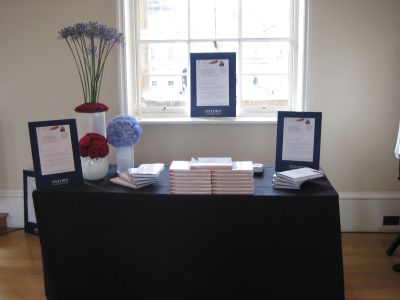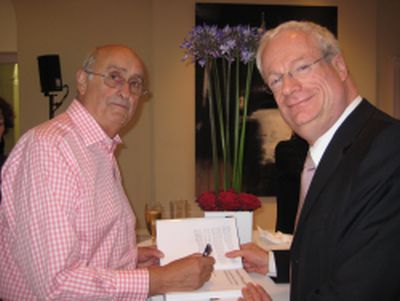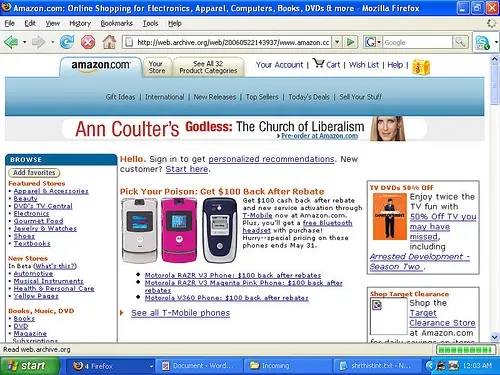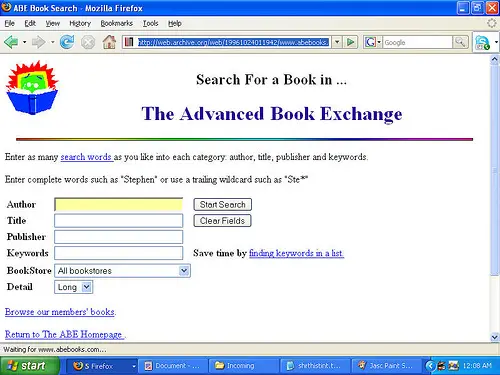
One of t he many upsides to being a publicist is getting to attend launch parties for our books. Of course, organizing them is hard work, but the night itself can be a lot of fun. We OUP-UK publicists were last week at what is shaping up to be our party of the season for the launch of Winston Fletcher’s Powers of Persuasion: The Inside Story of British Advertising, which publishes here later this week. Below are some photos from the event.
he many upsides to being a publicist is getting to attend launch parties for our books. Of course, organizing them is hard work, but the night itself can be a lot of fun. We OUP-UK publicists were last week at what is shaping up to be our party of the season for the launch of Winston Fletcher’s Powers of Persuasion: The Inside Story of British Advertising, which publishes here later this week. Below are some photos from the event.
Yesterday we posted a piece written by Winston Fletcher for OUPblog on when the British led the world in advertising.
Held at London’s incredibly beautiful Somerset House, we had a wonderful turn out including many of the great and the good from Britain’s ad-land, past and present. Winston gave an excellent speech where he confessed that though he had reached the top of his profession - he is the only person to have been both the Chairman of the Advertising Association and the President of the Institute of Practitioners in Advertising - he didn’t work for long in the creative side of the business. ‘Why?’, you ask. Well, when he did work in the creative side, he was the one who came up with the strapline “Have no fear, your piles will disappear!” for a campaign. He then decided he was better suited to the business side of advertising.


Also in attendance was former government Culture Secretary Chris Smith who is the current Chairman of the Advertising Standards Authority. He is pictured below with Winston Fletcher.

ShareThis

We recently launched Powers of Persuasion: The Inside Story of British Advertising by Winston Fletcher. Today, I am pleased to be able to bring you an original essay by Winston on the period where the British led the way in the advertising world. Check back tomorrow for photos from the party at London’s Somerset House.
Conventional wisdom has it that America is the home of advertising, where it all began. That is not quite right. Unquestionably America is the world’s largest advertising market, and American advertising agencies now dominate the world. But advertising began in ancient Athens (if not earlier), and advertising agencies started in Britain more than a century before they appeared in the USA. During 1970s and early 1980s British advertising led the world. It did so creatively – but it did so in other ways too, which underpinned the creativity, making it more effective and successful.
 The emergence of Britain started slowly. At the Cannes Festival, which was then – and still is – the arbiter of global advertising creativity, Britain was outpaced by the USA throughout the 1960s, and in 1970 and 1971. Then the British climb began. In 1972 British and American advertising agencies took home an equal number of Gold Lions (4 apiece), and Britain won the cinema Grand Prix. The next year Britain won more awards than any other country, though most of these were Silvers.
The emergence of Britain started slowly. At the Cannes Festival, which was then – and still is – the arbiter of global advertising creativity, Britain was outpaced by the USA throughout the 1960s, and in 1970 and 1971. Then the British climb began. In 1972 British and American advertising agencies took home an equal number of Gold Lions (4 apiece), and Britain won the cinema Grand Prix. The next year Britain won more awards than any other country, though most of these were Silvers.
In 1974 the British Gold rush really got going. That year Britain collected 18 Gold and Silver Lions and the Palme D’Or. In 1975 the festival moved to Venice for a year, and the British trade press headline simply read ‘Venice Goes British’. Come 1976 the festival returned to Cannes and the headline ran: ‘Britain Sweeps The Board’. The Brits had again pocketed the Palme D’Or, plus 10 of the 19 Gold Lions. In 1977 it was ‘Britain Comes Out Best Again’, with the Grand Prix for television and another 6 Gold Lions. Then, in 1978, Britain reached its zenith. The Brits won the Grand Prix for both television and cinema – a rare occurrence – and garnered a massive 80 Gold, Silver and Bronze Lions.
After 5 years at the top, there followed a couple of relatively fallow, but not wholly unsuccessful, years (1979 & 1980). But in 1981 the British made a come back (‘Britain Comes out Best Again’) with more Gold and Silver Lions than any other country. And Britain’s creative leadership continued throughout the first half of the new decade, when it collected 45 Gold Lions against America’s 23.
What caused this burgeoning of British advertising creativity? A combination of factors. Commercial television had begun in Britain in 1955, and for the first two decades British television advertising was dominated by American advertisers – particularly household cleanser and other packaged goods advertisers, whose approach to creativity was strictly formulaic. Every commercial had to abide by the ‘proven rules’. During the 1970s British advertisers started to become much more important in their home markets, and more confident, and allowed British creativity much more freedom. Creativity flowers in freedom. Moreover this occurred against the background of a recovery in Britain’s economic performance, after a long period of economic tribulation. But probably most important of all, there happened to be in London during those years a raft of quite exceptionally talented advertising people, who worked both as colleagues and as rivals to outperform each other creatively, in a highly charged competitive atmosphere.
Additionally, their creativity was underpinned by other developments which also helped British advertising leap ahead. More or less simultaneously, two London agencies (Boase Massimi Pollitt and J Walter Thompson London) invented a new system of campaign development called ‘account planning’. Account planning integrated research into the creative process in a way that had not been done before, and in a way that creative people found far more sympathetic than they had found earlier systems. Account planning spread slowly at first, but it is now generally accepted around the globe as the best way to develop new campaigns.
At the same time, in the mid-1970s. Britain developed the world’s best system of advertising self-regulation – a system that maximises creative freedoms within responsible constraints. And advertising began to be used more and more by British Governments to promote worthwhile social causes, from blood-giving to drink-less driving. Simultaneously Britain began to build what has become the world’s largest advertising archive, ‘The History of Advertising Trust.’ Out of this ferment of activity two commercial giants emerged: Saatchi & Saatchi and the WPP Group. Both joined the world’s advertising leaders, though Saatchi & Saatchi later stumbled and fell.
For the British advertising industry the second half of the 20th century was a heady era – when it reached peaks that it will probably never quite achieve again.
ShareThis
Now, internet commerce is my life blood, so I pay attention to elements of
it on a daily basis - how many orders are coming in, from where, for what,
for how much - basically boring but vital stuff. What I try to take a
more careful look at, from time to time is what forces are driving
commerce on the internet forward, and what, if anything, can I do about
it. Looking around this time I was left with a Where’s My Jetpack , where’s my damned bubble car feeling. While I’d had the
, where’s my damned bubble car feeling. While I’d had the
feeling, viscerally if not intellectually, that the internet was zipping
along and more in danger of leaving me behind than getting stuck in the
mud, this appears to be exactly what has happened to internet commerce,
especially that first great application, books.

Amazon in 1998 - look familiar?
Lets look back:
1995 I was connecting to my University’s server with a blazing 2400 baud
modem and zipping along fudging bibliographical entries for my grad school
papers on the text browser Lynx and Telnet. Often when connecting to
websites with creaky databases, I yearn for the days of telnet. Anyway,
one day we all moved to Netscape née Mosaic and,
lo and behold, there were pictures. Following along were Amazon and Ebay
and internet commerce - not just ordering products off of internet
bulletin boards - was born. At the time, and especially during the great Internet Stock
Market Bubble, it seemed like the internet would grow exponentially
unleashing brilliant technological advances every 8-10 seconds until the
universe collapsed in upon itself. If you’d listened to the media, you’d
have heard that this was actually happening, but if you look back at the
early days of Ebay and Amazon, it’s really hard to tell much of a
difference between then and now - the growing popularity of comparatively
backwards sites like craigslist and the
classifieds on Facebook are a testament to how far we haven’t come.

At least ABE was cuter in 1996.
The biggest difference (other than some more pictures and Amazon’s look
inside the book feature which we’ll revisit) is seller uptake. One of the
amazing things that the internet has unearthed is that sellers are
infinitely quicker to embrace new technologies than buyers. What this has
meant is that books you could sell on the old ABE or Ebay for $50 because,
pre-internet, they had been locally scarce, now can’t be sold for $6 and a
bag of chips. Capitalism encourages the breaching of new markets, but
consumers are much more stuck in their ways than the more desperate and
enterprising sellers - this leads to some, let’s say interesting, supply
and demand disparities. Obviously, it also means that ridiculously
obscure books that were on interest to no one locally can now be sold for
$250 in a flash to the four people 1000 miles away who are jonesing for
it, but this tends to happen below the surface, for now we’ll focus on the
surface.
Twelve years ago I used to cruise Onsale
the early internet auction site (which, who knew, still exists in some
form) and buy piles of great stuff that they were liquidating. I used to
have boxes of steak delivered from Omaha steaks for pennies on the dollar,
exotic meats - I bought an $8,000 couch for $400 and still have it in my
living room. Buying weird stuff on the internet was fantastic in the
early days - sellers had jumped into this new distribution system with
both feet and the comparatively few buyers out there were reaping the
benefits. It’s easy to think this has radically changed, but the same
dynamic is still largely at play, it’s just been turned on its head a bit.
Strange and rare items are now offered at a premium, and common items are
worthless, but in both cases the cause is largely the huge number of
sellers relative to buyers.
Innovation has been limited (have a look at any of the book sites via the
Internet Archive’s Way Back Machine which archives sections of the internet)- the internet is
still basically an electronic version of a print catalog, with little to
recommend it, particularly bookselling wise (clothing has actually come a
long way - but clothing is a much harder sell online, so they’ve had to
work harder and this has turned them into leaders), as an alternative. In
some ways it’s amazing that so many people are willing to shop for books
online, given how basically lame it is. What innovation there is has
largely been of either the bells and whistles variety, or part of a Seller
Cold War, driven by the aggregator sites, usually Ebay. Compare shopping
at Amazon to shopping at Nike.com or designing your own jeans at Lands End - it’s not very exciting. There are
a few items of interest though, that may point the way to the future of
bookselling.
1 - Look inside the book. This has finally moved bookselling into the
realm that music has occupied for some time - being able to sample the
product before buying. What will be interesting is whether this, and the
Kindle and related readers, starts to sink sales as perception as to what
a book is begins to change. Music, once freed from the confines of the CD
and record, rapidly evolved into a “shareable” rather than buyable,
medium.
2 - Amazon reviews. What was once a good start on user generated content,
now seems decidedly Web 1.0. With the advent of Wikipedia, tag clouds, and social
networking, static customer reviews are of limited helpfulness is
navigating the vast world of new and used books.
3 - Ebay has done a great job encouraging the use of pictures online - a
must for forward thinking booksellers. However, they’ve also encouraged
sellers in a mutual assured destruction arms race with bold listings,
gallery listings, featured, featured plus, featured super extra bold plus,
etc. Most of these features could be done without - and if sellers all
got together and decided not to use them, it would be the same as everyone
using them. Just like in the prisoner’s dilemma though, win wins are hard
to orchestrate.
4 -Between the Covers is an independent site that has done a great job of maximizing Web 1.0
features. A likable site, 3-D rotating books, and book related games lend
a stickiness and character to their book selling. It may not be the
future, but if it’s the past, it’s the best of it.
What some of this suggests is a path for the future of online selling.
Robust flash based shopping sites like Nike’s are both more fun to shop
on, and more intuitive to navigate. They are also, at least in theory, no
more difficult to run as a front end than current sites. If coupled with
additional content, the conceptual framework for which has already been
laid by Amazon, they could begin to utilize the strengths of the internet
and lead us beyond the electronic versions of paper catalogs that we
remain stuck with.
For example: Amazon reviews are great as far as they go - they allow
customers, and some paid reviewers, to enhance individual book listings
with deep content. Why not move into the current internet and allow users
to generate all sorts of content. It’s already been shown by sites like
Facebook, Wikipedia, Digg, and others, that the cheapest and most
effective way to both generate content and create loyal users, is to allow
them great latitude in adding information to sites. Why not let them tag
items, comment on titles - even comment on pricing. On a site like ABE
where sellers hit the site much more than buyers (and have more invested
in it) you would rapidly generate useful content that, coupled with tag
clouds and the like, would allow navigation of the site in new and
potentially profitable ways. Crowd sourcing (as they call it) can be
extremely unpredictable, and the actual results can scarcely be guessed
at, but it’s shocking that no one has given it more of a shot.
ABE’s purchase of a stake in LibraryThing suggests that they
see this future, but nothing has been done to link the sites since their
May 2006 investment. They need to at least run a beta test linking the
sites and see what happens - the only way I see to inspire a new
generation of collectors is to embrace the social networking of the
internet and let people pursue their interests. As general searches on
both Google and in book selling databases become less reliable, and
browsing more pointless as stock grows, an alternate avenue for finding
what you’re looking for is vital.
Amazon’s look inside the book - and the long history of music samples
online - also suggest ways to enhance the selling of books. Why not link
to a books google books page, OCLC listing, or, even better, the Open Library (an improved, open content
version of Google Books in the early stages of development but showing
great promise). Sadly, this is easier on Amazon than ABE because of the
cataloging system Amazon licensed from the British Library, but it should
be possible. You could even have much of the user content on Open
Library, potentially helping both ABE and Open library.
I’ll have some ideas for hastening the future of online book selling in
Part II, but just imagine how all those late adopters and potential
customers out there would hop on the internet and buy stuff if it didn’t
continue to seem like an extremely complicated version of a print catalog
or a lame version of The Home Shopping Network. If infomercials and
television shopping channels continue to survive, it’s only because the
internet isn’t doing what it ought to be.
Posted by Tom Nealon of Pazzo Books
– Pazzo Books 4268 Washington St. Roslindale, MA 02131 pazzobooks.com 617-323-2919
ShareThis
he many upsides to being a publicist is getting to attend launch parties for our books. Of course, organizing them is hard work, but the night itself can be a lot of fun. We OUP-UK publicists were last week at what is shaping up to be our party of the season for the launch of Winston Fletcher’s Powers of Persuasion: The Inside Story of British Advertising, which publishes here later this week. Below are some photos from the event.









[…] we posted a piece written by Winston Fletcher for OUPblog on when the British led the world in […]